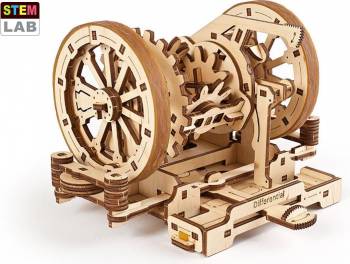70132 STEM LAB Differential
Assemble it and discover the principle of working of the Car Differential.
- Experiment: the model comes with a Pocket Model’s Study Guide with a creation story and mechanism design as well as engaging and interesting tasks.
- Immerse yourself in Augmented Reality (AR), find out how the Counter is used in a production line, and interact with it via the dedicated Ugears application.
Learn how the DIFFERENTIAL works
The Differential is a stylised educational model, an interactive study guide to the mechanism, only for learning its essentials and principles of working. The Differential was designed to ensure that the drive wheels sitting on the same axle rotate with a different rate and cover different distances at the same time. This mechanism allows the car to make turns without the wheels skidding, prevents wheel-slip, reduces tyre wear, and makes entering and going out of turns easier for the driver. Having assembled the Differential, you can unblock it pushing the lever in position 1 (Up) and set both wheels in motion by rotation of the drive gear or the wheel. The Control lever regulates the smooth locking of the left and right wheels independently by turning left or right respectively. In the “down” position of the lever, both wheels are linked in a rigid coupling and can either rotate together (propelled by the drive gear or a wheel) or lock simultaneously (by the lever of the wheel).
When and who invented it
The car differential was invented by French engineer Onesiphore Pecqueur in 1825. In the 1930s of the 20th century, German automotive engineer Ferdinand Porsche made significant improvements to the device.
Usage
Differentials are used mainly in cars as a part of the transmission mechanism. They improve maneuvrability and performance of a car.

